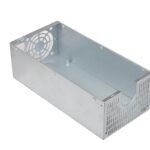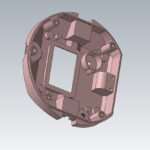Aluminum is the heart and soul of CNC machining; it is a soft yet sturdy metal with universal appeal. The flexibility of aluminum is evident in its finishing options as well. The most popular finish for aluminum is anodization. But the anodizing process can be complicated, and most newcomers feel intimidated by the sheer number of options.
So, here is an in-depth breakdown of anodizing aluminum. Everything you need to know is condensed into one small article.
What is Anodized Aluminum?
Metals react with the oxygen in the air to form a protective oxide layer on the surface. Anodization is increasing the thickness of this oxide layer; the newer, thicker surface finish is called an anodic coating.
Anodizing is a popular finishing for non-ferrous metals, like aluminum or titanium. Aluminum has a natural corrosion resistance because of its oxide layer; we can further increase the strength of this layer through anodization.
The anodic coating is much harder than pure aluminum, thus protecting the metal underneath, making it scratch resistance and increasing corrosion resistance. Additionally, you can paint anodized aluminum because of the rougher oxide layer.
What are the Different Anodizing Types?
The three most common anodizing specifications are,
Sulphuric Acid or Anodizing Type II
Chromic Acid or Anodizing Type I
Sulphuric Acid Hard Anodizing or Anodizing Type III
“Types” is an incorrect term to describe anodizing classifications, and “Types” is used when there is a clear difference between members of a category. In comparison, terms like “Grades” or “Specifications” are used when there is very little difference between these members.
For Example, steel, aluminum, and copper are all different types of metal. But Al 7075 and Al 6061 are different grades of aluminum. Similarly, chromic acid anodizing and sulphuric acid anodizing are different specifications of the same process.
The confusion about terminology certainly arises from the most common names for anodizing specifications. “Type 1 Chromic Acid Anodizing” is the name of an anodizing specification and not an anodizing type.
This topic is covered in detail under the “Anodizing Specifications” subheading.

How is Aluminum Anodized?
Anodizing is an electrochemical process where the aluminum is submerged in a chemical bath, and an electric current is run through the chemical to the aluminum. Following are the basic steps involved in the anodizing process,
Cleaning Steps
1.First, the aluminum part must be sanded or polished to remove any machining marks or surface roughness.
2.A clean solution removes any dirt or oil from the aluminum part.
3.The aluminum part is rinsed in clean water to remove any leftover cleaning solution.
Etching Steps
4.Next, the part must be submerged in an alkaline solution, usually caustic soda. This step removes a thin layer of aluminum, so the part has a uniform surface finish and better anodizing efficiency.
5.A second rinsing is required to remove residual caustic soda.
Anodizing Steps
6.The negative terminal of the power supply is connected to the aluminum part; this is our anode. The positive terminal is connected to a cathode, and aluminum 6063-T6 is a commonly used cathode.
7.The anode and the cathode are submerged in an acid bath, typically sulphuric acid. The anode and the cathode must not touch each other. The electrolytic process generates a lot of heat, so the acid bath needs to be at a low temperature.
8.Once the power supply is powered on, the current will flow. The cathode will cause negative oxygen ions to form in the acid bath. These ions will move towards the positive anode and bond to the aluminum part. The current causes small pores on the anode surface; these pores are useful for aluminum coloring.
9.The duration of the anodizing step determines the thickness of the oxide layer, and longer times result in a thicker oxide layer.
10.Afterward, the aluminum part is rinsed in a deionizing solution to prevent discoloration and spotting.
Coloring Steps
11.Immediately after the deionization bath, the aluminum part can be submerged in a dye solution. Here the dye enters the pores on the aluminum part.
Sealing Steps
12.Finally, the aluminum part can be submerged in a final boiling water bath. The high temperatures cause the dye to harden and seal the aluminum.
Coloring Anodized Aluminum
Coloring is a core advantage of the anodizing process. Coloring on anodized aluminum doesn’t chip, wear or peel off as it is embedded into the aluminum and then sealed. Currently, there are four methods of introducing color to anodized aluminum,
Electrolytic Method
After the anodizing step, aluminum is submerged into a metal-salt solution. When an electric current runs through the salt solution, the metal ions are deposited into the pores on the anode (our aluminum part). Copper, nickel, tin, and cobalt are commonly used metals for electrolytic coloring.
This method is also called the two-step coloring method.
Interference Method
The interference method is the bigger brother to the electrolytic method; it supports a wider range of colors using light refraction. After anodizing aluminum using sulphuric acid, it undergoes another anodizing process with phosphoric acid. Causing the pore structure of the anodic coating to widen at the base and increase in height. When metal is deposited inside the pores, using the electrolytic method, the outer walls of the pores interfere with the light refracted from the metal resulting in a new shade of color.
This method is sometimes called the three-step coloring method.
Integral Method
The Integral method combines the coloring and anodizing process into one step. A separate metal compound is added to the sulphuric acid during the anodizing process. Resulting in simultaneous creation of pores and deposition of metal. The metal compound used here is some form of oxygen-embedded metal like manganate or molybdate.
Dye Method
The dye method is the simplest method of coloring anodized parts. Immediately after anodizing, the aluminum part is dipped into a liquid dye solution, and the anodic coating absorbs the dye. The intensity of the dye color is dependent on the thickness of the anodic coating, the solution temperature, the dye amount, etc.

Anodizing Specifications
Anodizing can be further divided into different types; these types are depended on the acid and voltage used during the anodization process. There are various anodizing specifications and standards, but the most popular ones come from the U.S. Military, labeled MIL-A-8625.
The MIL-A-8625 specification only details 2 types of anodizing.
Type I – Chromic Acid
Type II – Sulfuric Acid
Type III – Sulfuric Acid Hard Anodizing
Other Anodizing specifications involve the use of organic acids (malic acid, oxalic acid, or sulfosalicylic acid), phosphoric acid, or higher voltages.
Types I
Type I anodizing uses chromic acid as an electrolyte, resulting in a thinner anodic coating but higher corrosion resistance. Type I has the thinnest anodic coating, and as discussed previously, dye coloring is dependent on coating thickness. So, Type I will typically have less impressive coloring options.
Types II
Type II is the most common anodizing process; it uses sulphuric acid as an electrolyte, resulting in a thicker anodic coating. Type II is also highly preferred for its excellent dye absorption capabilities.
Types III
All anodizing processes are the same, with the only two differentiating factors being acid and coating thickness. Type III proves the statement mentioned above because it is the same as Type II but with a thicker anodic coating.
According to U.S. Military specifications, you can only call an anodizing process Type III if it can produce a coating thickness of 50µm or greater. The increased thickness results in even better corrosion resistance and increased durability. The harder anodic coating is why Type III is commonly called hard anodizing.
| Characteristics | Type IChromic Acid | Type IISulphuric Acid | Type IIIHard Anodizing |
| Anodic Coating | 0.08 – 0.25 µm | 2.54 – 25 µm | 12.7 – 80 µm |
| Porosity | Low | Medium | High |
| Durability | Poor | Moderate | Excellent |
| Corrosion Resistance | Good | Good | Excellent |
| Environmental Friendly | No | Yes | Yes |
| Applications | Aircraft PartsDecorative Finish | Kitchen AppliancesArchitectureFishing Equipment etc. | High Durability Parts |
Choosing the Right Anodizing Process
Anodizing can be tricky, but choosing the right process for your machined aluminum part is easy. Color, durability, and cost are the three most important factors. And you can use the table mentioned above to select the process that best suits your needs.
Color
The dye coloring method is the cheapest and most commonly used method for dozing aluminum. But it will yield less impressive results using Type I anodizing and has a limited color range.
Cost
Cost is a manufacturer-specific factor; Type III anodizing is the most expensive choice. But if you don’t need high durability or corrosion resistance, Type I and Type II are excellent choices.
Durability
Durability is a relative property and is heavily dependent on application. For most consumers, Type II anodizing will yield the best results.
Color, durability, and cost are closely related; if you change one, it will affect the other two.

Increasing Anodizing Efficiency
Following are four design factors that can help you increase the efficiency of anodizing aluminum.
Pre-Processing
Anodizing is a uniform and microscopic process; any imperfections in the aluminum part will be evident afterward. To avoid a poor surface finish, you can process your aluminum with a different finishing process before anodizing. Sanding or Bead Polishing are common pre-processing steps for anodizing aluminum.
Dimension Tolerance
When anodizing aluminum, you need to be mindful of the increase in thickness of the part. Either you can compensate for the thickness increase during the machining process or use a thinner anodizing finish, and type I and Type II anodizing are preferred for tight tolerances.
Sharp Edges
The electrolytic process involves current flowing from the cathode to the anode. And sharp edges act as a lightning rod for electric current, causing an excessive increase in temperature. To avoid the high temperatures which result in overheating and sometimes burning, use slightly rounded corners and edges.
Batch Sizes
Etching is a very imprecise process. Since the chemistry involved takes place at a microscopic level, maintaining uniformity in different anodized parts is difficult. Working in large batches removes minor inconsistency between parts; it ensures all parts are submerged for the same time and receive the same amount of coloring dye.
Benefits of Anodized Aluminum
Anodized aluminum has various application-dependent benefits. We have previously discussed most of these benefits, so here is a summary of those benefits.
Anodizing can affect the base properties of aluminum, some directly, some indirectly.
Direct Benefits
Direct benefits come from the base anodizing process and require no additional post-processing.
1)Corrosion Resistance
Aluminum already has decent corrosion resistance, but the addition of an anodic coating further improves this property. Pure aluminum has a thin oxide layer for protection, but most anodic coatings are 1000 times thicker.
2)Scratch Resistance
Anodic coatings aren’t just corrosion resistance. Aluminum oxide is harder than pure aluminum, so even thin coatings result in a scratch resistance finish.
3)Durability
Durability is slightly different from scratch resistance because high durability is only possible with thicker anodic coatings. Aluminum is a softer metal than steel or titanium, so the increase in durability opens more application options for aluminum.
Indirect Benefits
Anodizing has some great indirect benefits; these are benefits that only show up after additional post-processing.
1)Insulation
Aluminum is a good conductor of electricity, but a new opportunity for insulation appears with anodization. The rough surface of anodized aluminum is perfect for insulating coating like Polytetrafluoroethylene (PTFE).
2)Coloring
Coloring is not the primary goal of anodizing aluminum. But it is an excellent by-product of the porous nature of anodized aluminum.
Conclusion
Now that you have read this article, you know the basics of anodizing aluminum. We hope this article helps you decide on the ideal surface finish for your machined aluminum parts.
If you want some excellent aluminum machining, we recommend QBH technology. We provide various CNC Machining and Sheet Metal Fabrication Services. Additionally, we have an excellent range of the best post-processing options. QBH prides itself in its unbeatable quality and excellent Surface Treatment Options.
Send us your designs and specifications, and we will give you a competitive and personalized quote.




